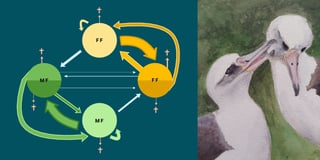Demat! Bonghjornu! Egun on! A look at regional languages of France
Hi there! I’m Margaux, head of Customer Success at Datawrapper. For my first Weekly Chart in two years, let’s have a look at regional languages in France.
A couple years ago, I moved back to France after six fun years in Berlin, and one of the things I really wanted to do was travel around the country. Even though I did go back “home” when I was living abroad, those weeks were usually spent with family, in familiar places. So a few weeks ago, I finally travelled around the southern half of France, and I noticed that road signs were written in regional languages — in this case, Occitan — in many more places than what I would have thought.
Diverse but disappearing
There are about 68 regional languages in France, more than 50 of which are spoken in the overseas territories. In the region where I spent my vacation, the local language is Occitan, a very old Romance language that was once spoken by as much as a quarter of the French population.
Roughly speaking, you can divide regional languages into a few categories, including langues d’oïl in the top half of the country and langue d’oc (or Occitan) in the bottom half, as well as Breton, Basque, Corsican, Alsatian, and Arpitan, to name a few. They clearly show the historical diversity of what we commonly see as one country, France.
Most of the regional languages of mainland France are Romance languages, created by a blend of older local languages and the influence of the Roman Empire. Occitan evolved in a region which was Romanized much earlier, and so is closer to other Mediterranean languages, whereas the langues d’oïl (which include standard Parisian French) retain more Celtic elements.
All these languages have their specificities, their own culture, songs, and art. It’s very hard to precisely define how many people speak them nowadays, but a recent survey of 3,500 people around the country found that only 18% had even some knowledge of their regional language — and real fluency might be ever rarer. The numbers continue dwindling as the older speakers pass away.
Keeping the languages alive
Still, there are efforts in each region to keep these languages alive. Since 1951, the teaching of regional languages has been allowed in school, and there are schools in Brittany (Diwan), the Basque country (Seaska), Occitania (Calandreta), Alsace (ABCM-Zweisprachigkeit), Catalonia (La Bressola) and Corsica (Scola Corsa) that teach all classes in the respective regional languages — in total, that’s 188 schools and more than 14,000 students keeping those languages alive.
I’ve dug through the websites of cultural centers, universities, and a whole bunch of regional associations to try and track down the voices of those who do the work of keeping these languages alive. In the map below, you can click on the dots to hear regional languages used in songs, stories, and even recipes:
One of the oldest examples of Occitan is a song by a 13th century trobairitz named Beatriz de Dia, for which we still have both words and music. It tells the story of a woman in love with a man, but he ignores her and is being very arrogant, which she doesn’t hesitate to point out and criticize. Pretty modern considering the time!
This recording is another one of my favorites, because it talks specifically about being forced to learn French. It’s from Savoy, where people spoke a dialect of Arpitan. A part of it goes, “It’s been a long time that we've said patois is dead, but I’d like to show you Savoyards are quite stubborn. Forced to speak French in school, they always came back and spoke patois at home,” and later continues, “French is just good to entertain babblers, leave us our patois for the real stories.” It shows how strongly cultural identity is tied to the language, and how foreign French seemed to these populations then.
As early as the 13th century, all administrations started writing in French, to distance themselves from the influence of the church and its language, Latin. In 1539, French became the official language of the administration, as per a law passed by Francis I. French, in this context, referred to the dialect spoken around Paris, where the court was. This began a long tradition of centralizing power in the Paris region, which is still clearly visible now — there are more work opportunities, more cultural events, and 10% of the overall population lives there.
After the French Revolution, a series of laws were passed (and sometimes cancelled again) that aimed for everyone to speak French, and to limit the use of regional languages. The official goal was to promote a unified nation where all citizens were equal — and while that is very true, and French allows us to communicate as one entity, it also participated in the erasure of many languages tied to regional identities, some of which are now only spoken by a few hundred people. I can’t help but think how hard it must have been to live in a country where all administration is virtually inaccessible to you.
And in fact, that is still happening. While I focused on older languages of mainland France and Corsica in the map, many regional languages are still widely spoken in the overseas territories. In Guadeloupe, Martinique and La Réunion, for example, there are respectively 88%, 90% and 82% of the population that speaks Créole in addition to French, according to a 2022 report of the Ministry of Culture. For a lot of them, Créole is their first language, and the language of everyday social interaction. In 2008, the Constitution was amended so that regional languages are officially “part of the heritage of France,” but that doesn’t give them any special administrative status.
I’m very glad that so many people are putting in the effort to keep regional languages alive, and learning about all of them was fascinating. There are tons more I couldn’t fit here, and when I watched some videos and heard some recordings, I couldn’t help but notice a certain anxiousness and emotion that comes with preserving something so fragile and fleeting as language, so easily lost whenever their speakers disappear.
Aquò's tot per uèi — that’s it for today! I hope you found it interesting too; next week you’ll hear from Toni for another round of the Weekly Chart.



